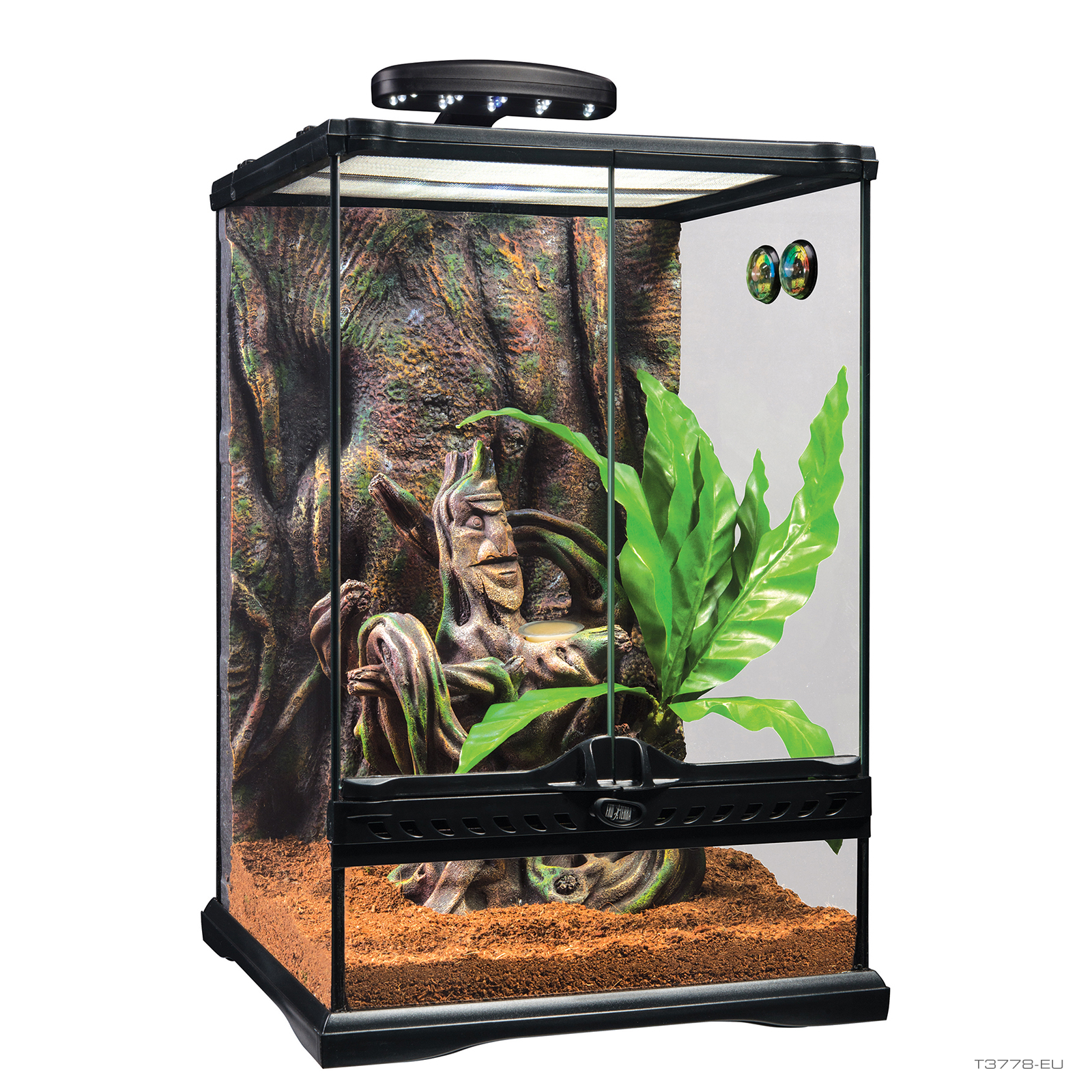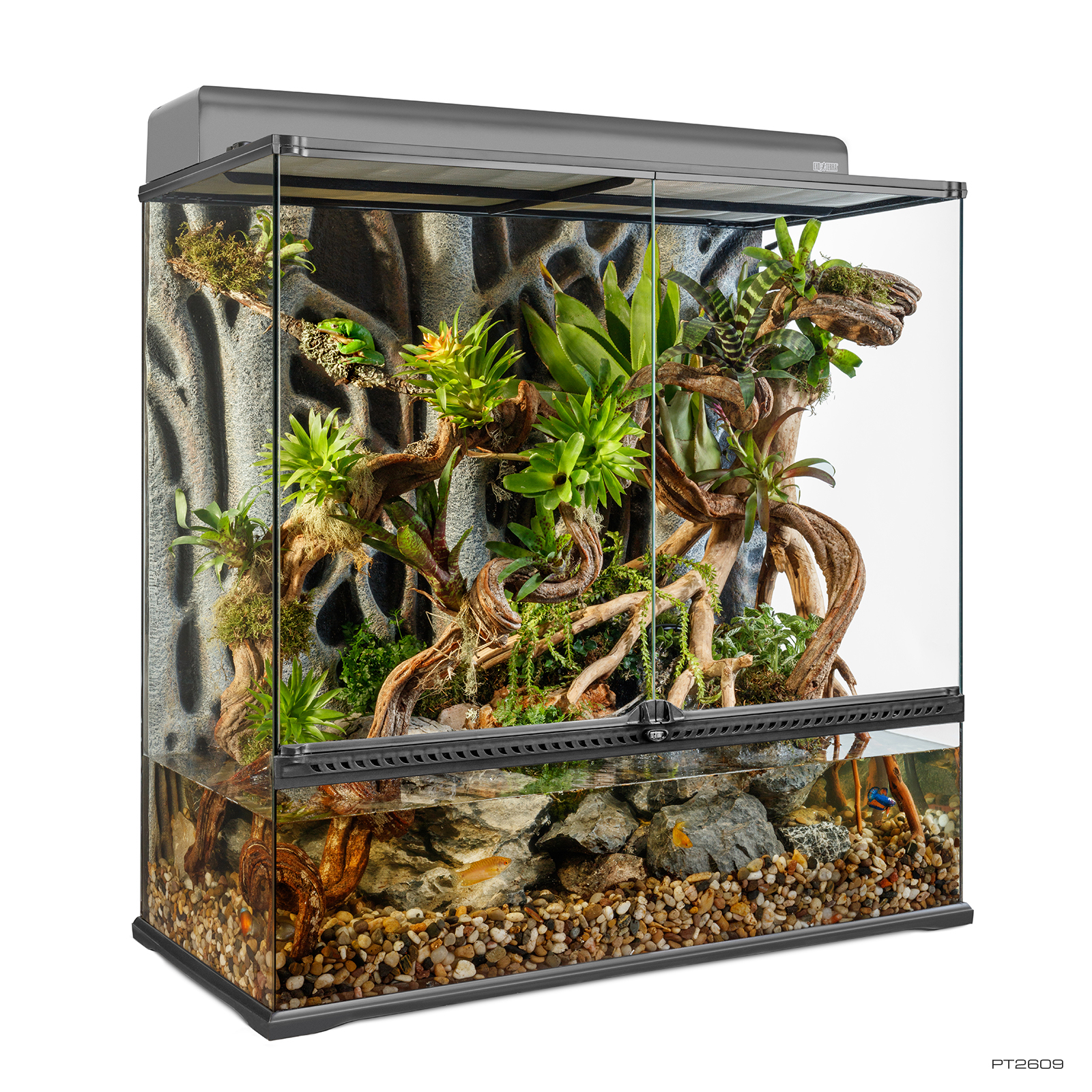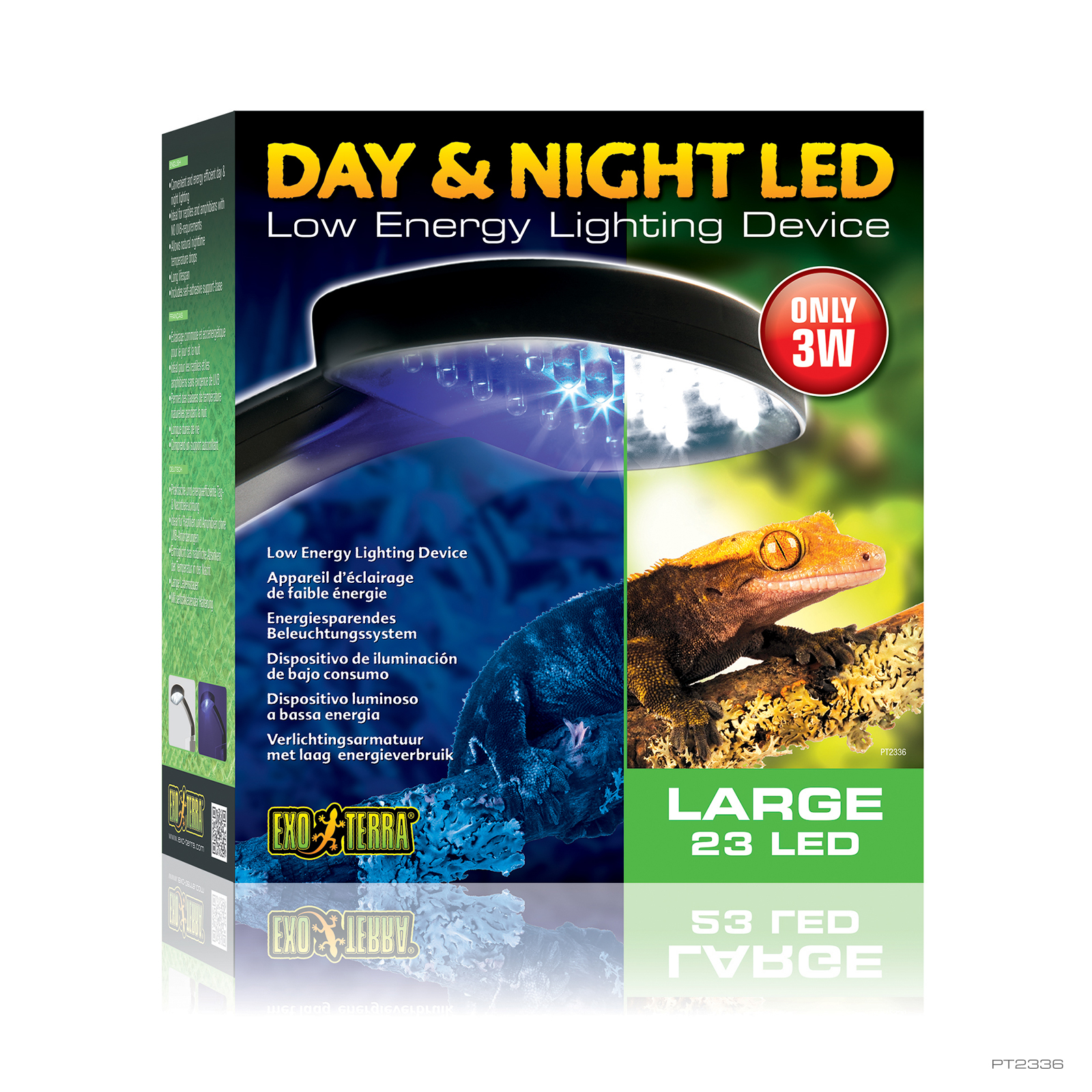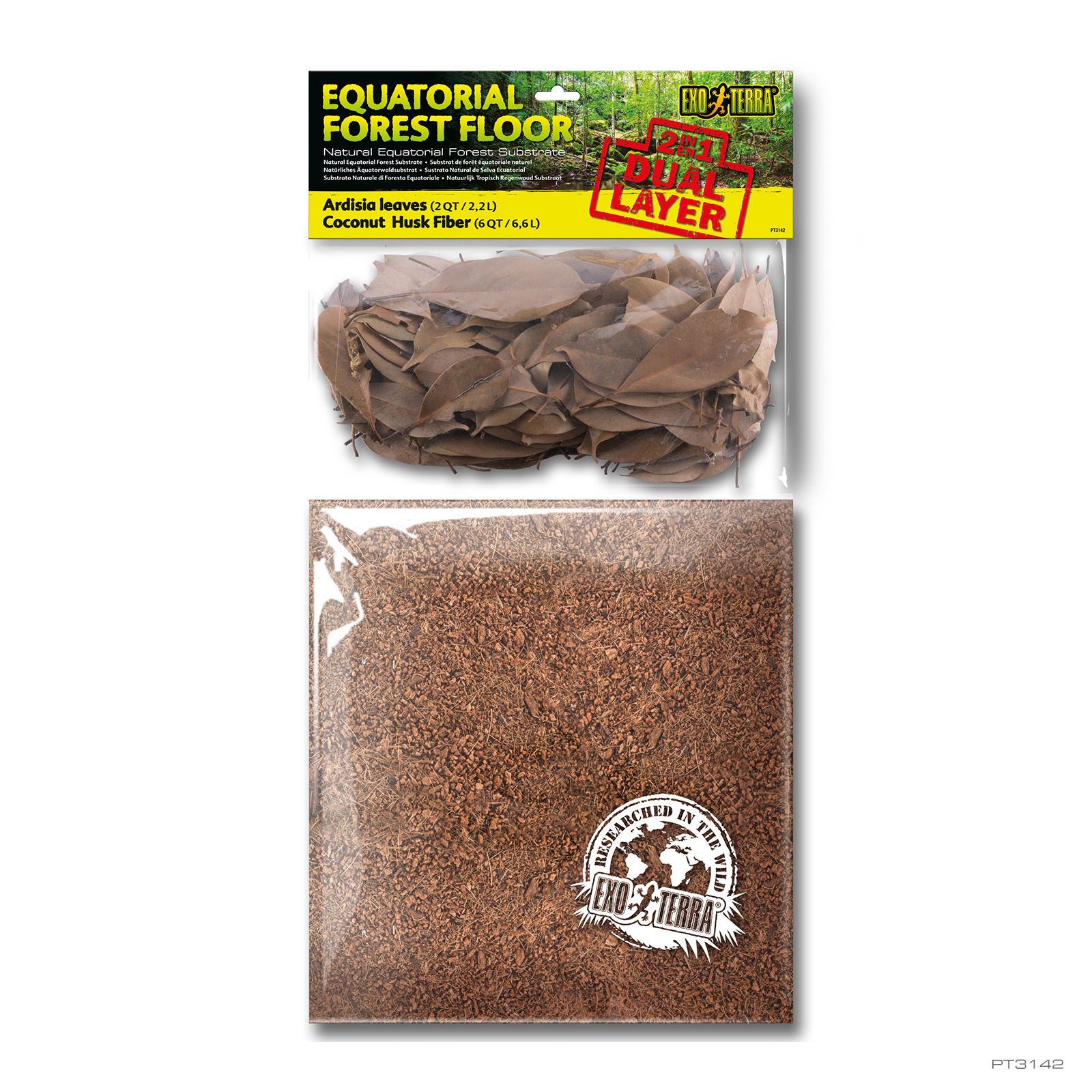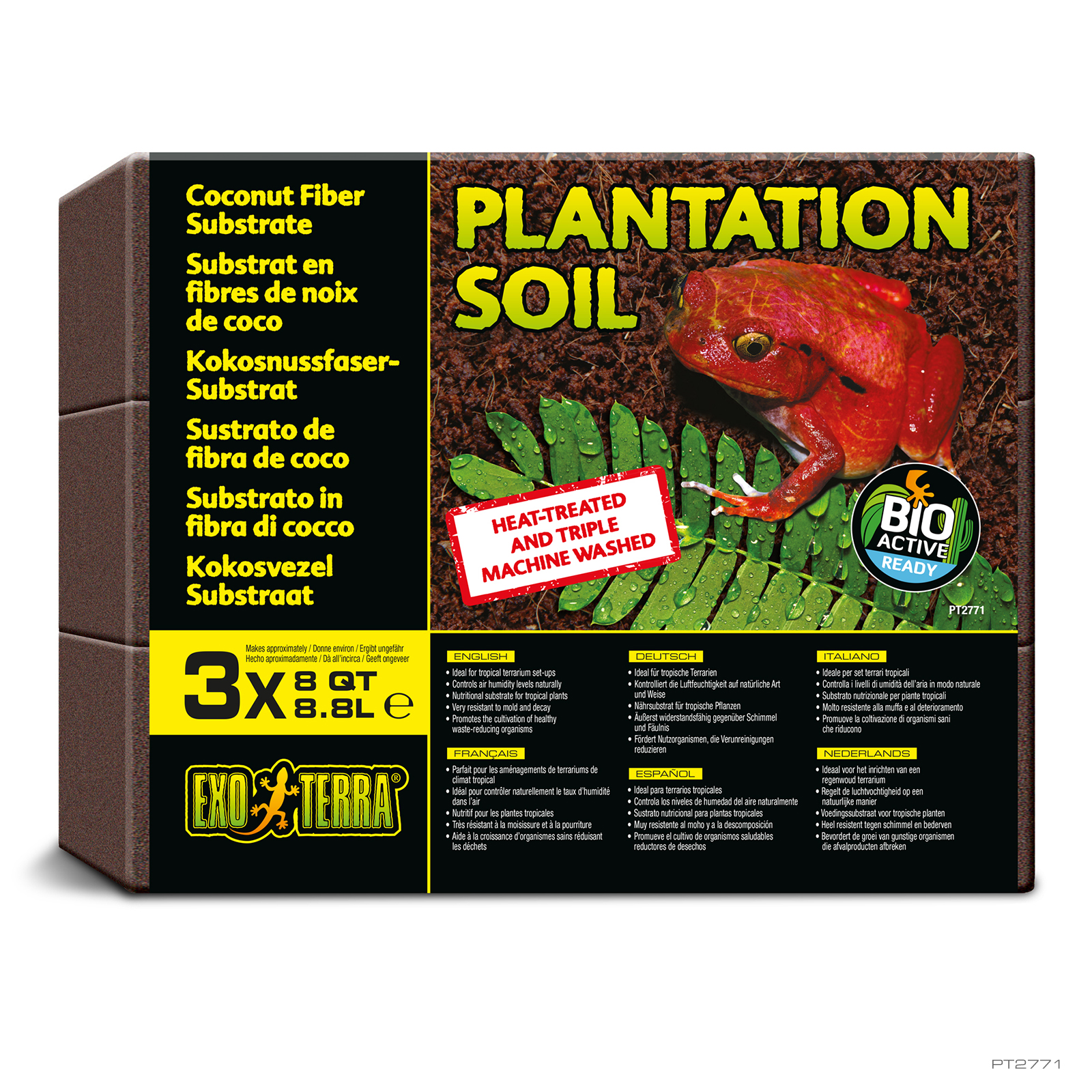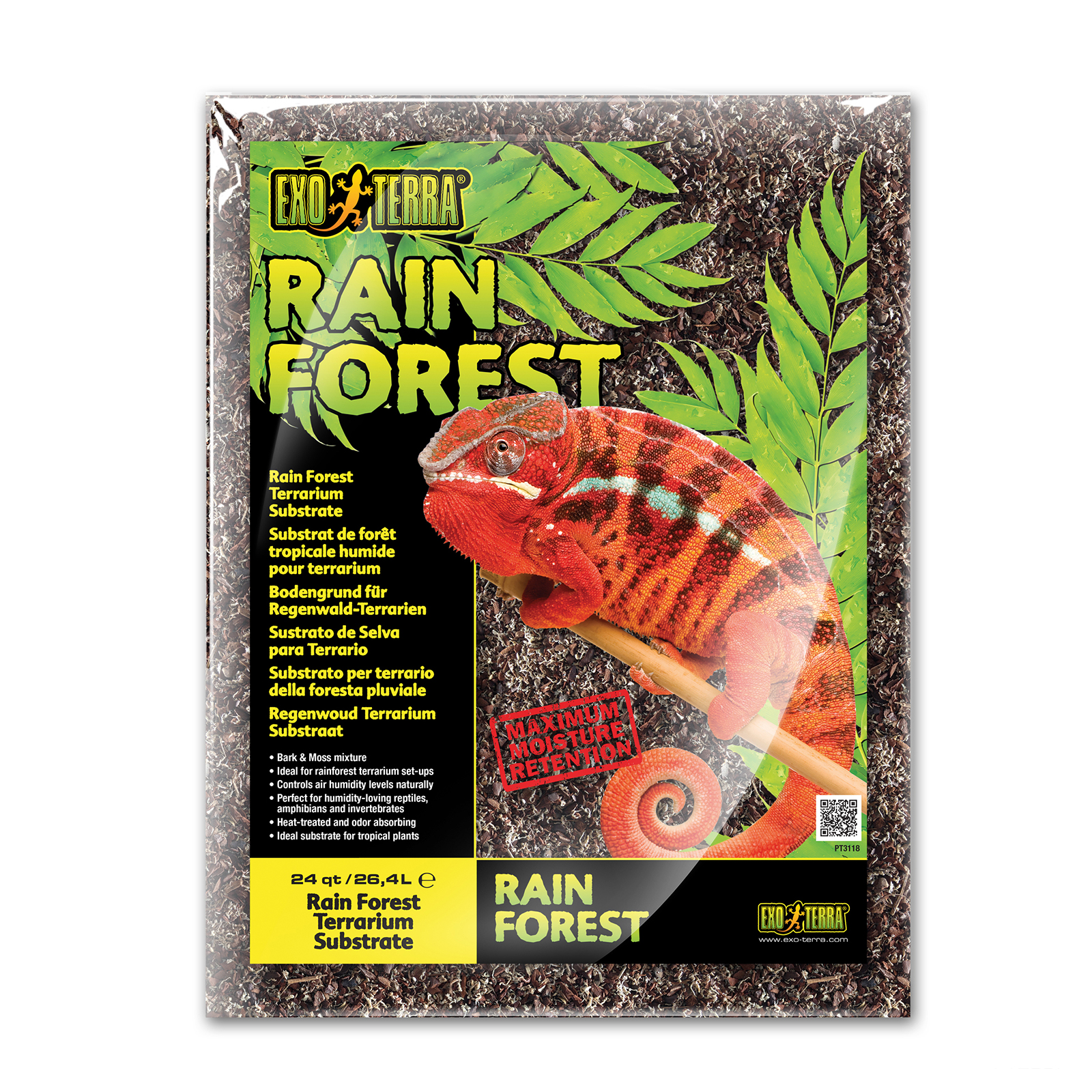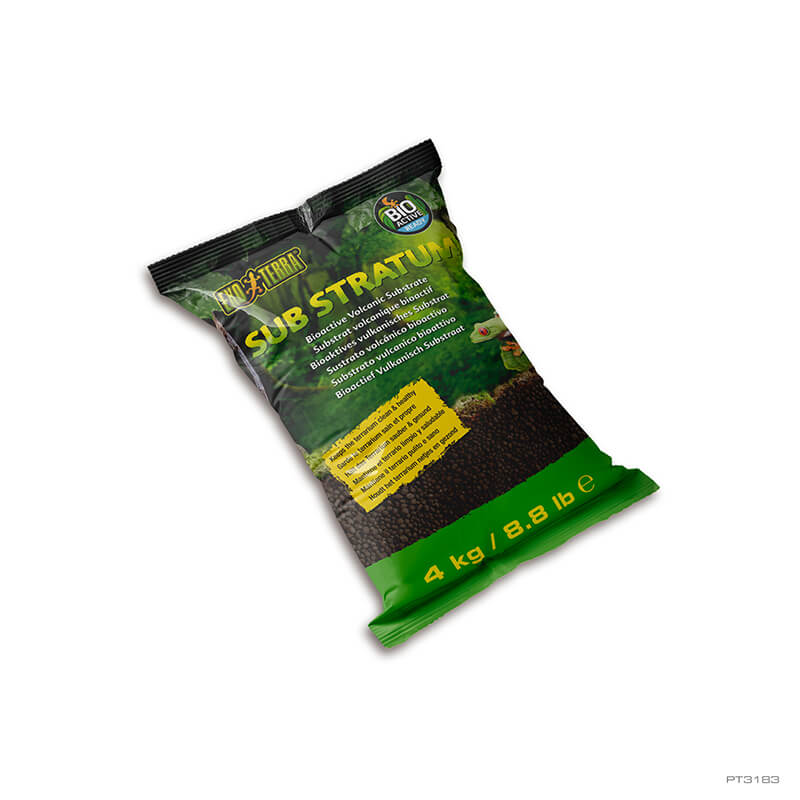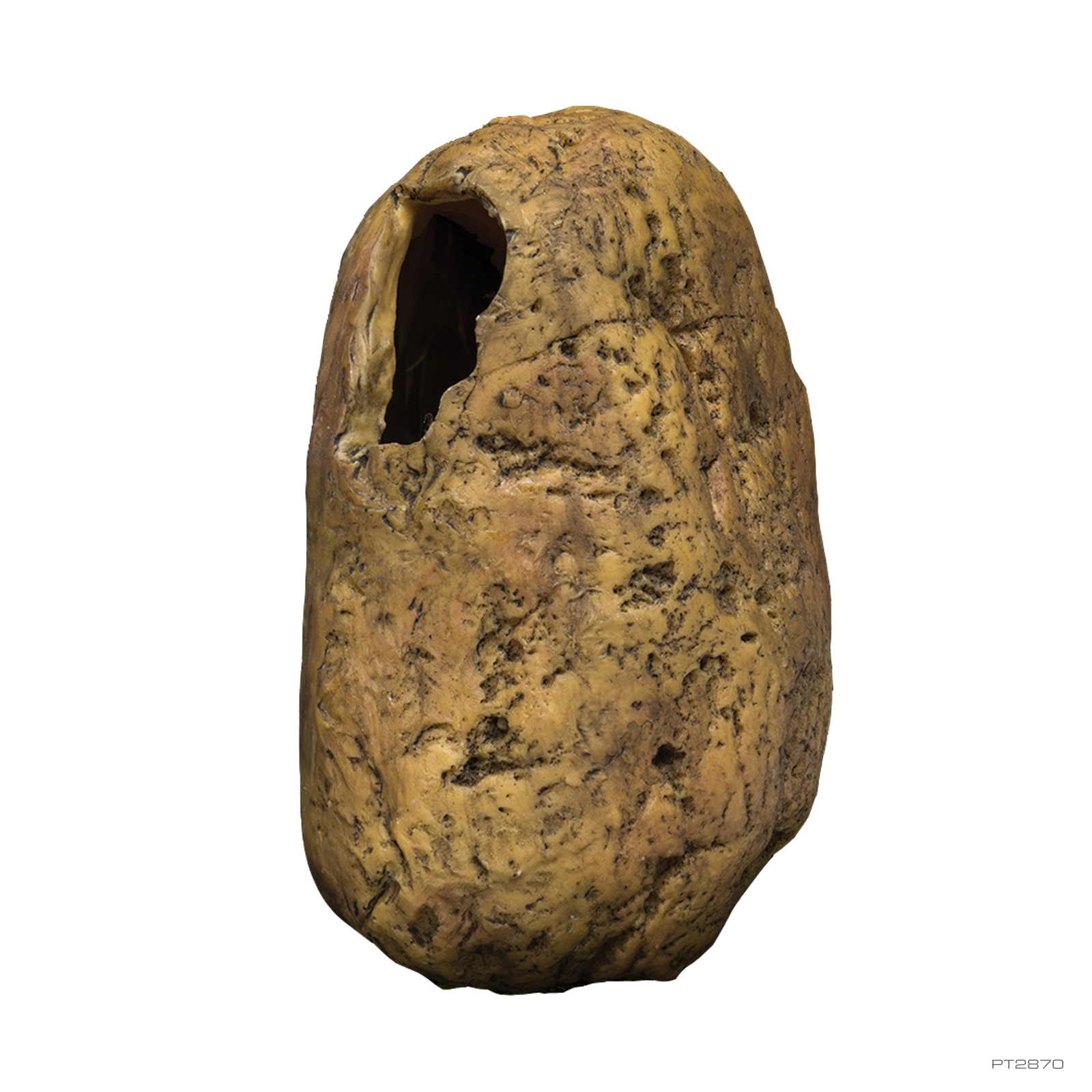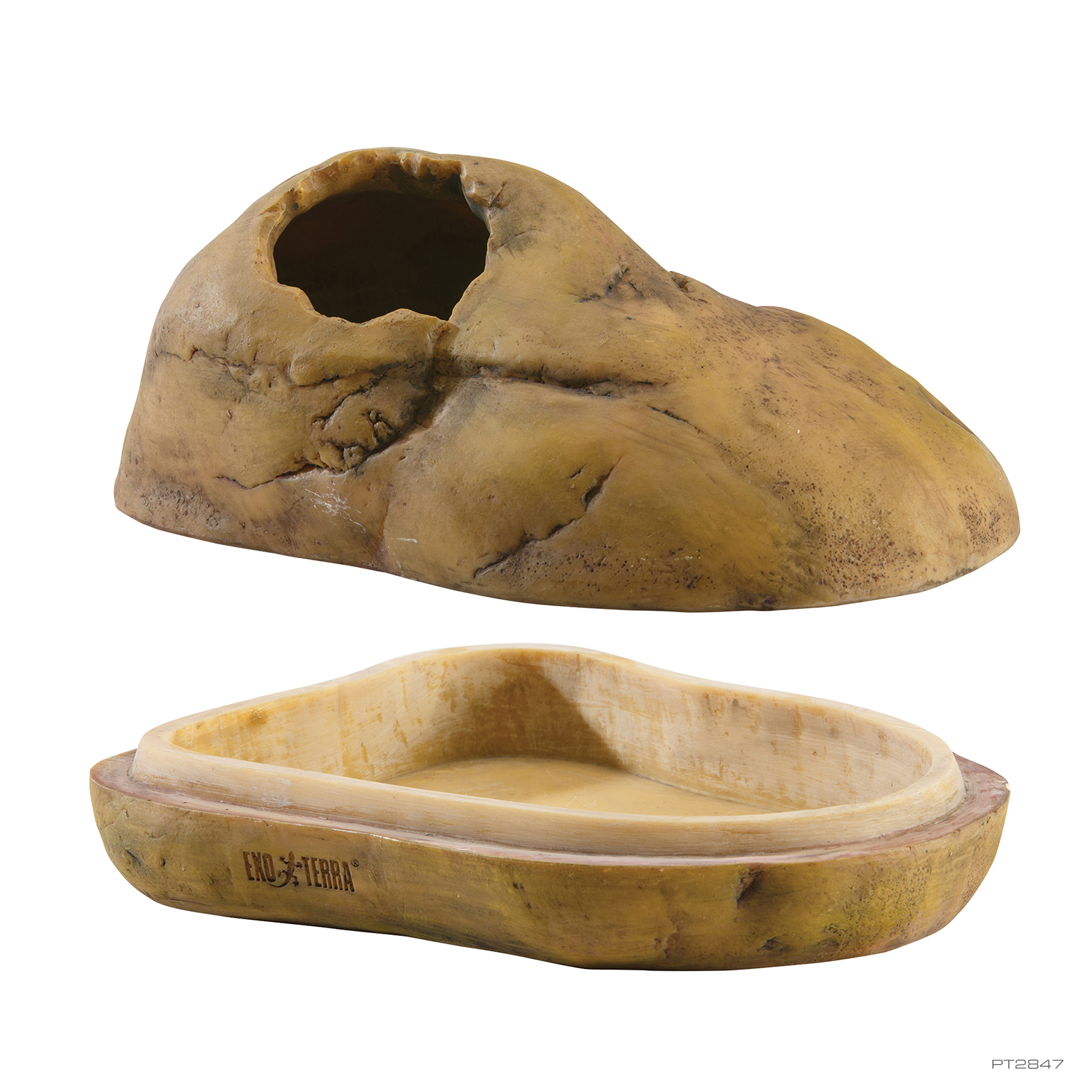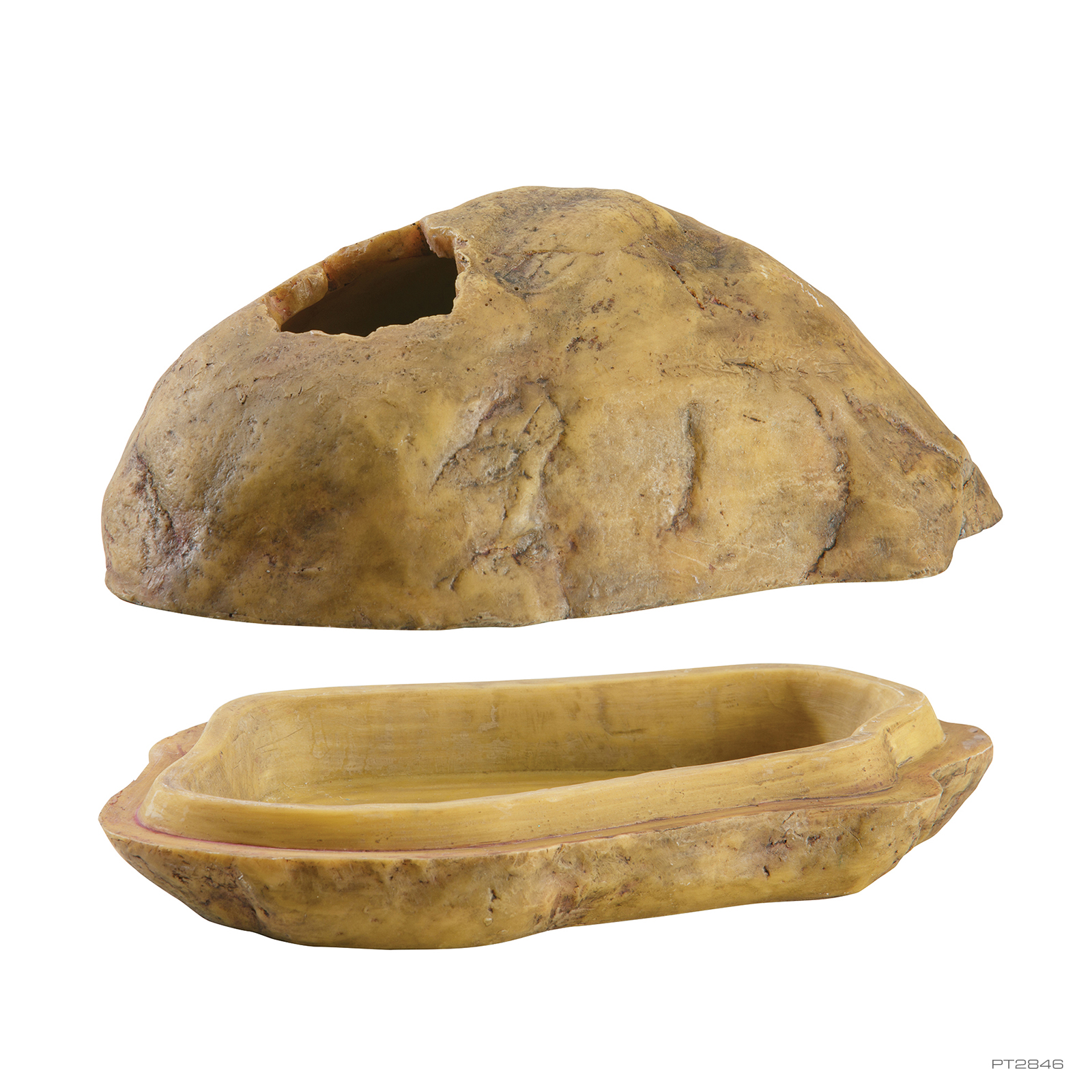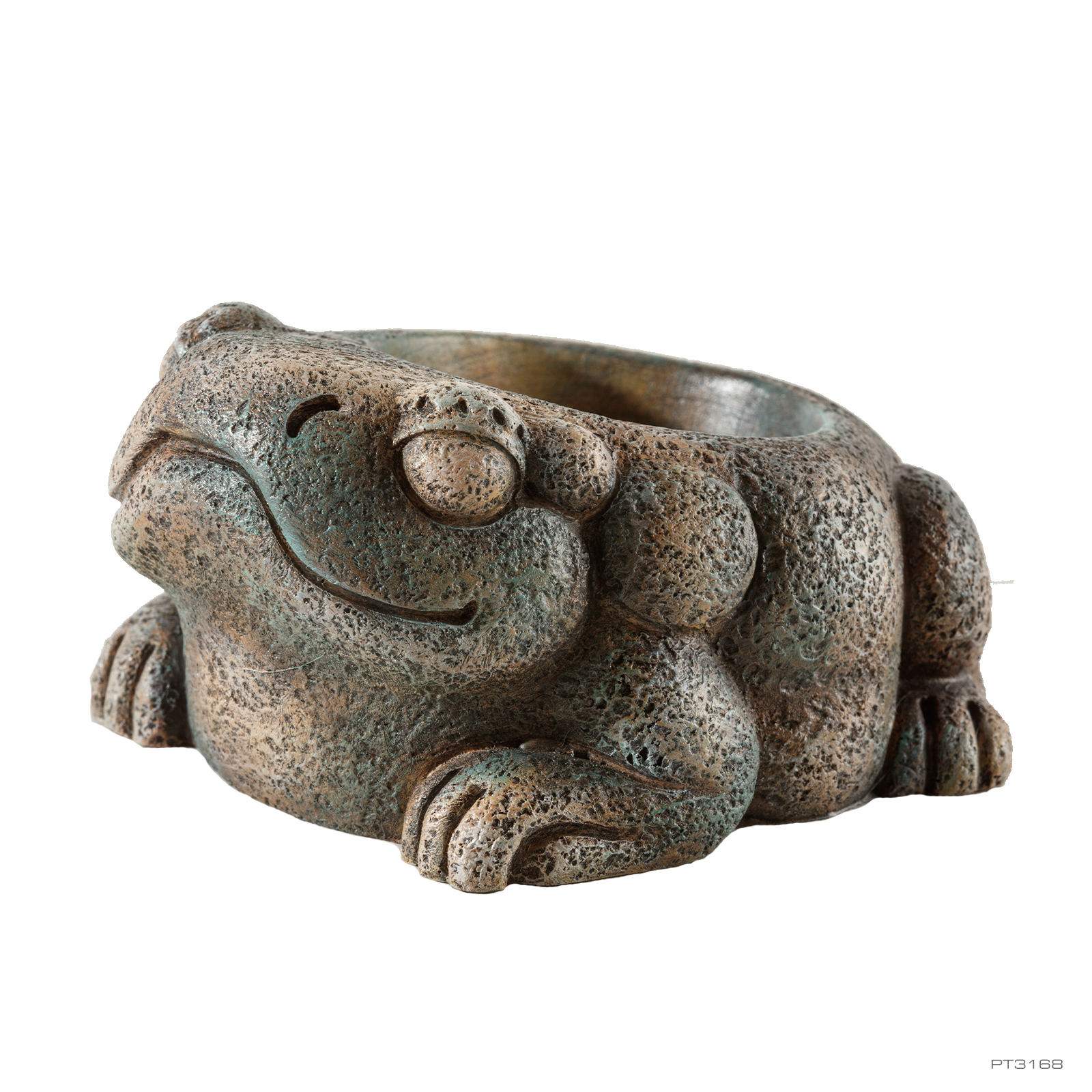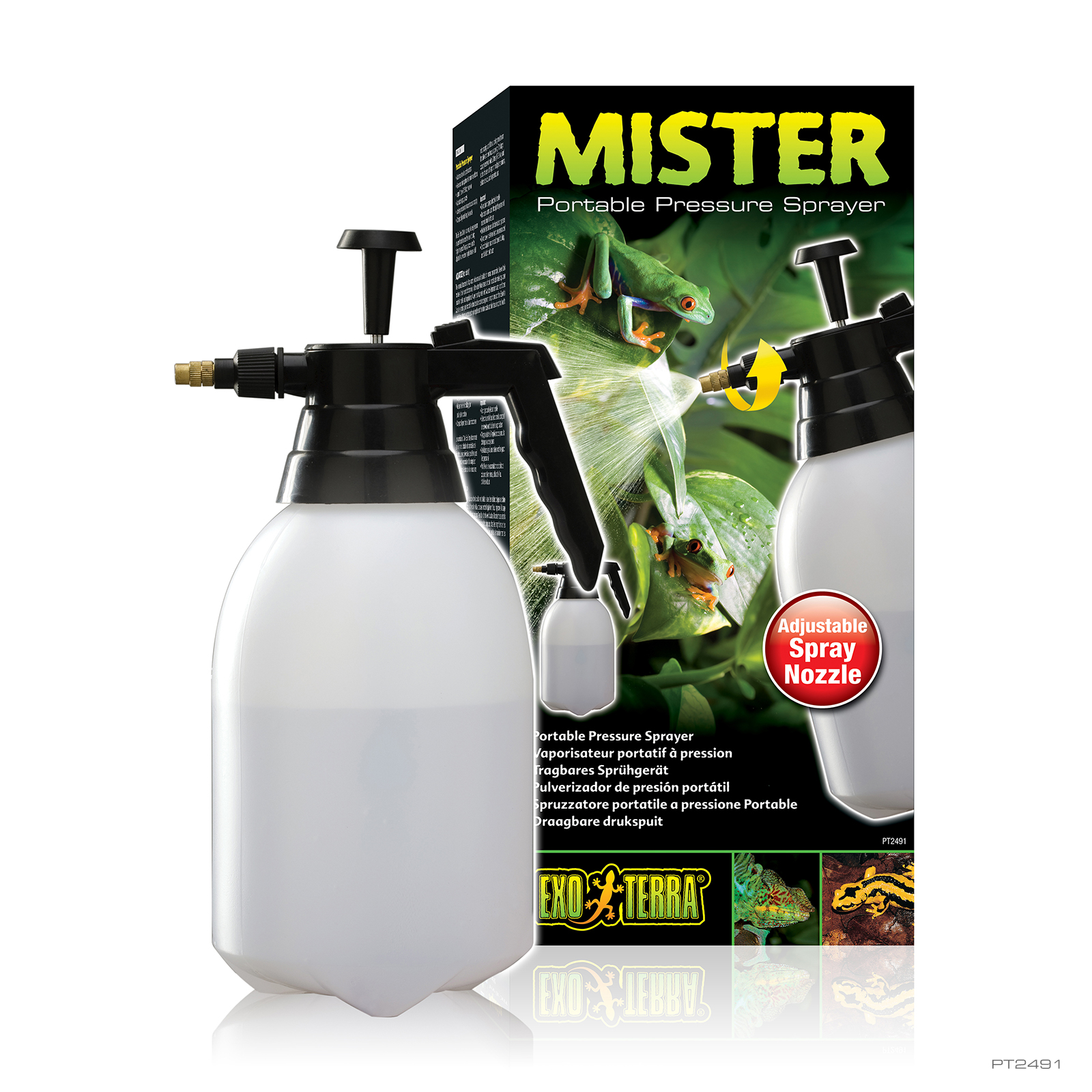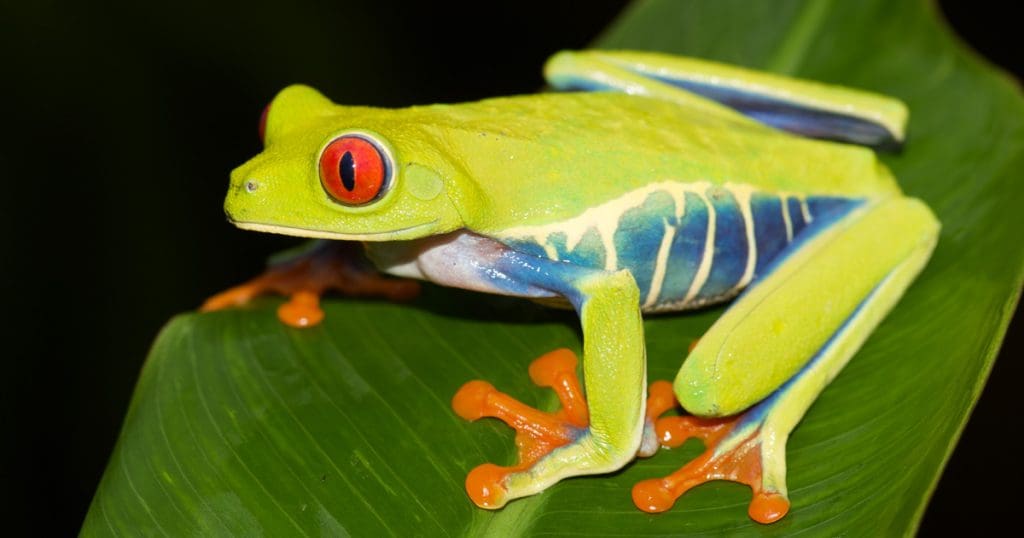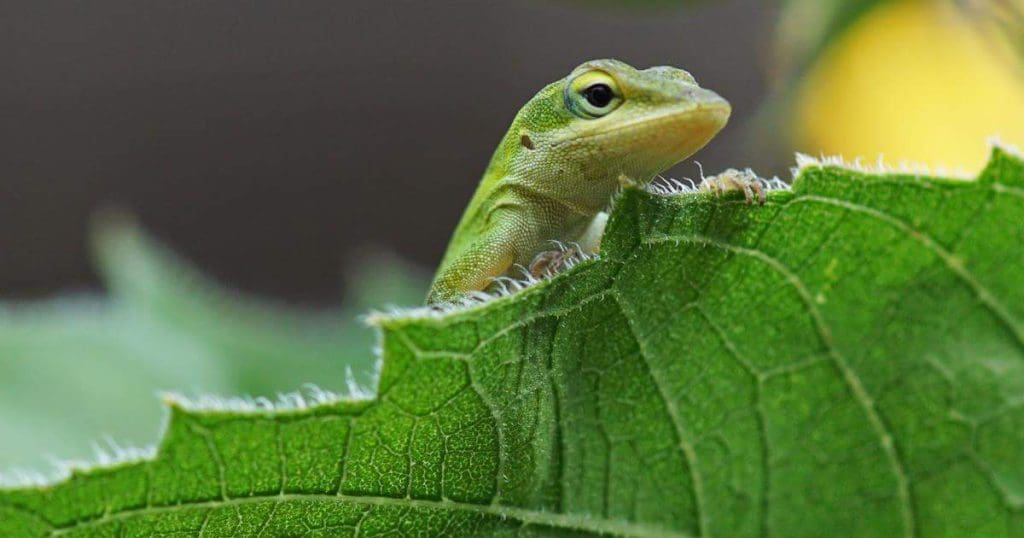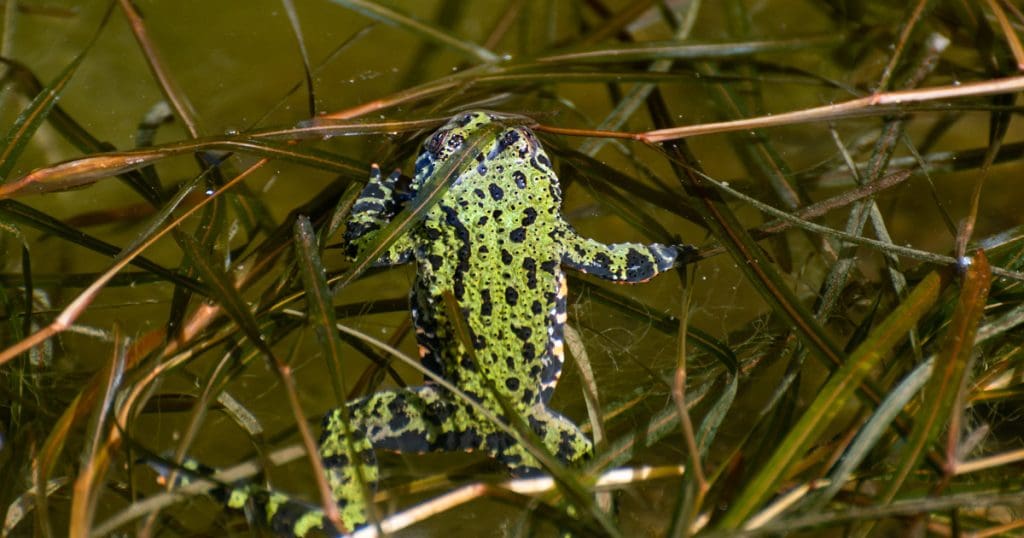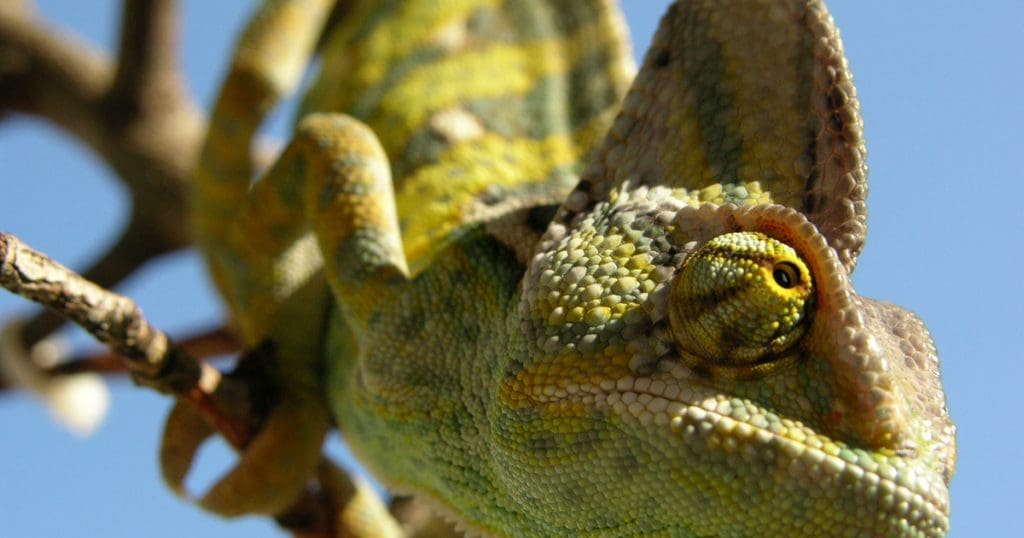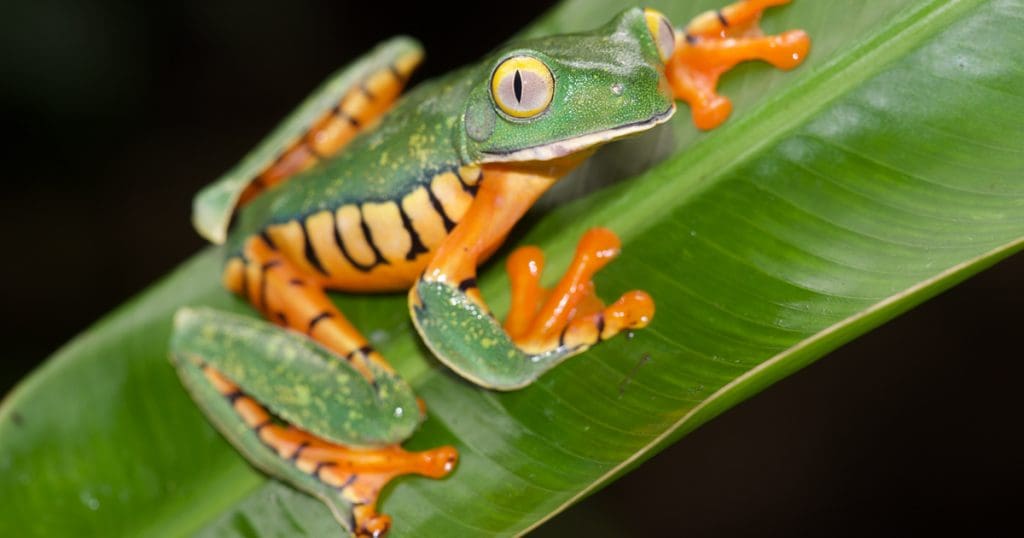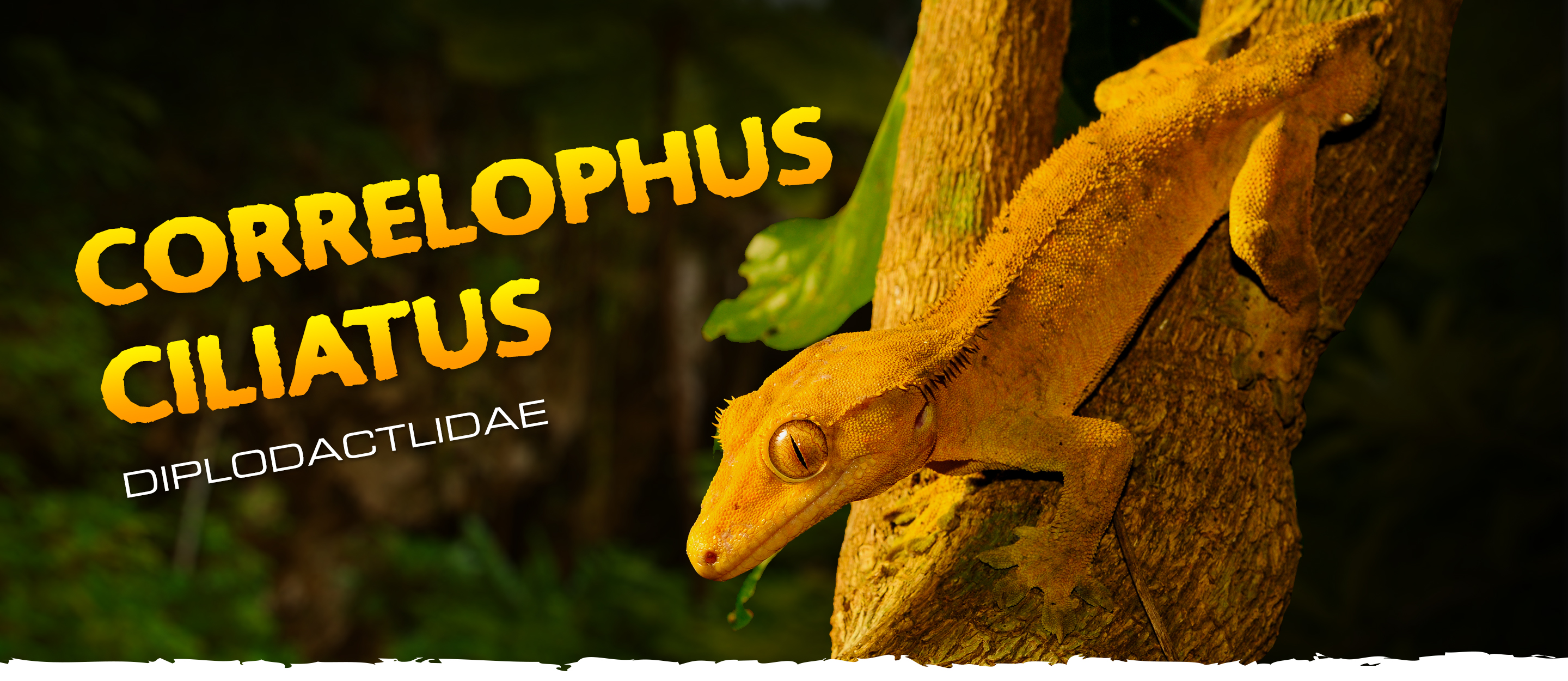
Correlophus ciliatus
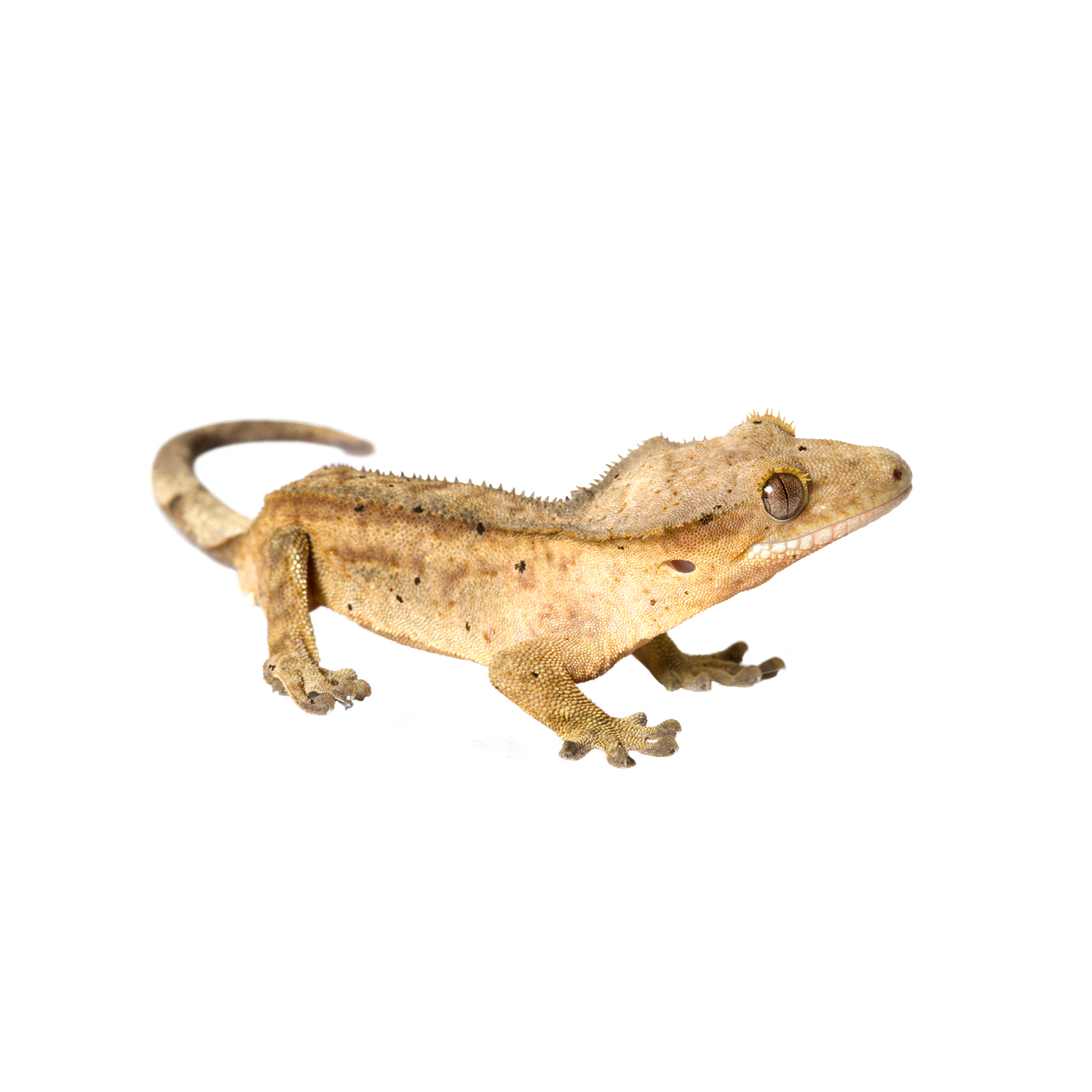

Crested Gecko
Crested Geckos (Correlophus ciliatus) are native to the islands of New Caledonia in the southern Pacific Ocean. These Crested Geckos, or Eyelash geckos, get their common names from the distinctive rows of spikes that run over their eyes and down the sides of their heads.
Thought to be extinct for many years, they were rediscovered in 1994, and several animals were brought to Europe and the United States. Soon thereafter, they proved to be very prolific in terrarium. Due to their beauty, easy manageable size, calm temperament, and ease of care in terrarium, these geckos have become one of the most popular reptiles kept as pets.
“One of the great accomplishments of herpetoculturists,” says Philippe de Vosjoli, “was to establish the New Caledonian Crested Gecko in captivity. Twenty years ago, this species was known by hobbyists only in the form of photographs of preserved museum specimens.”

History
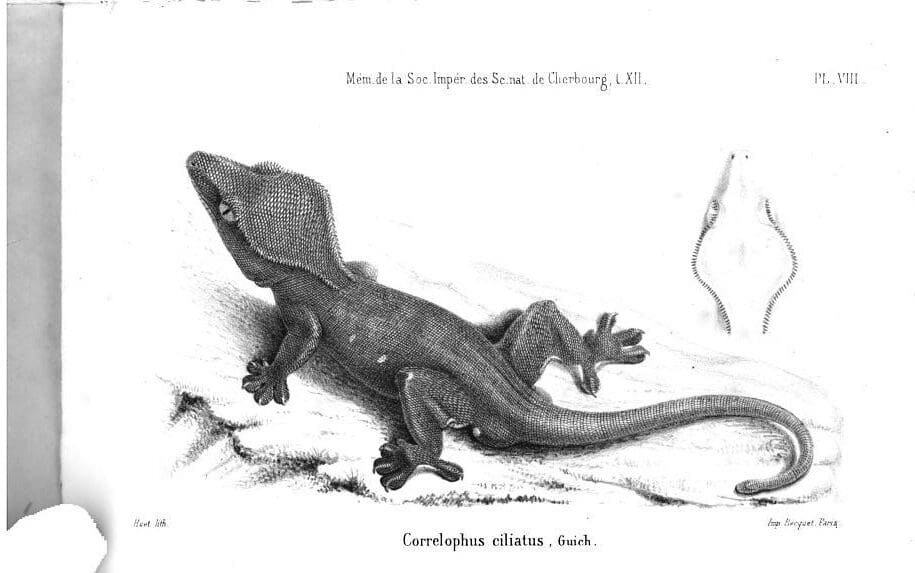
The Crested Gecko was first described in 1866 as Correlophus ciliatus by Guichenot, but in 1883 Boulenger classified it in the genus Rhacodactylus. In a revision of the New Caledonian giant geckos, the Crested Gecko’s name was re-established as Correlophus ciliatus by Bauer et al. in 2012.
Up to 1993 Correlophus ciliatus was known from only 16 specimens collected from a single locality on Grand Terre (the largest Island of the archipelago), so it was presumed crested geckos were extinct as they had not been seen or collected for over a century (Bauer & Sadlier 1993).
Then in 1994, following a tropical cyclone, there was a report of a Correlophus ciliatus being sighted on the Isle of Pines (a satellite island south of the larger Island Grand Terre). As a result of this report, the renowned German herpetologist Wilhelm Henkel and his colleagues visited the Isle of Pines and rediscovered Correlophus ciliatus.
Several specimen where brought back to Europe to study their behaviour in captivity. Just a few months later, American herpetologists Philippe de Vosjoli and Frank Fast also explored the Isle of Pines and in turn took specimens back to America to begin a captive breeding program.
From only a few specimen, Correlophus ciliatus became very well established in captivity over the past few years, and is now one of the most kept reptile species in terrarium today!
Characteristics
Crested Geckos belong to the family Diplodactlidae and the infraorder Gekkota (Geckos).
The head is unusual in being triangular and flattened. The purpose of this design has not been studied but is likely the result of their habit of moving in and between foliage, with eyelash-like crests serving as sensory structures and eye protection. The pointed snout may also help for digging or hiding in leaf litter and probing between layers of foliage.
The main feature is a row of crests made of elongated scales lining the eyes, sides of the head and to varying degrees along the upper sides of the body. A peculiar characteristic of crested geckos is that, unlike most geckos, they do not regenerate their tails when dropped, but only produce a tiny pointy knob.
The original museum specimens lacked tails and it was believed this species could be tailless. Virtually all adults found in the wild lack tails. The long high contrasting tail was uncovered after hatching the first captive-bred specimens.
As many breeders have discovered, crested gecko babies, if underfed, readily consume the tails of their tank mates. Larger juveniles can find the tails of smaller ones particularly appetising. Breeding adults may also drop tails. Thus, in nature the tailless condition appears to be the norm with this species.
Males and females range from 4 to 4.5” or 10 to 12 cm snout-to-vent length (SVL), and 7.5-9” or 19-21 cm in total length. Adults weight between 35-60 grams.
Male Crested Geckos become sexually mature between 10 to 15 months and females at 12 months of age, or at a weight of approximately 35 grams. After 3-4 months of age, the external hemipenal bulge at the base of the tail becomes visible in males. In contrast, females are flat at the base of their tails, with much smaller bulges.
Distribution
The Crested Gecko is endemic to New Caledonia. Populations are fragmented with several localities on the main island (Grande Terre), near Rivière Bleue, Mont Koghis, Mont Ouin and Mont Dzumac. One population is recorded on the Isle of Pines (Île des Pins), but not on its surrounding islets.
In the Wild
Crested Geckos in the wild are mainly arboreal, and are excellent climbers and jumpers as they are equipped with lamellae and tiny claws on each toe which help them cling on smooth surfaces and grasp twigs and branches. The tips of their long prehensile tails also have a flattened end covered in lamellae, as they use this tail to help balance and secure themselves as they move through the trees.
Like most other geckos, Crested Geckos can drop their tails as a lure for an enemy when startled or threatened. Virtually all adult specimens of Correlophus ciliatus observed in the wild had no tail. In contrast with some other gecko species that live in New Caledonia, in this species the tail does not regenerate; only a short tail stump of a few millimetres grows again. The causes of tail loss are many, from predator attacks to interspecies interactions to simply stress.
Its major enemies in the wild are larger geckos (Rhacodactylus lechianus), feral cats and particularly rats. However, for some time now the Crested Gecko is threatened by a tiny fire ant originating from South America, it is locally called "fourmis électrique" (electric ant).
During daytime, Crested Geckos sleep mostly in between the thick foliage of plants, especially in the epiphytic Bird's-nest ferns (Asplenium sp.). They cling to overlapping leaves with their spread toes and flattened bodies.
They emerge at night, climbing and jumping through the smaller trees, lower shrubs and lianas in search of insects, berries and plant nectar to eat.
Crested Geckos mainly live in the undergrowth of the forest up to a height of around four metres above the forest floor. They are virtually never found on thicker trees, but mostly on the thinner branches and the small lianas that are common here or on the higher twigs of shrubs.
The smaller Correlophus ciliatus is presumably forced to the lower regions in the forest by the larger and more dominant species like Rhacodactylus lechianus and Miniarogekko chahoua, who claim the more robust branches and tree trunks.
Crested Gecko females generally deposit their two eggs in tree hollows or crevices, but are sometimes hidden on the forest floor between leaf litter or decomposing tree branches.
The temperatures recorded at 2 metre above ground level in the habitat of Correlophus ciliatus, fluctuate between 22°C and 29°C in the daytime and 16°C and 22°C at night - depending on the season. February is the warmest month of the year, while August is the coldest month of the year. The driest months are from August through December.

In the Terrarium
Crested geckos are primarily arboreal lizards and will only descend to the ground for feeding, egg-laying and under certain conditions to find hide-outs. For this reason they require tall terrariums to accommodate plants and climbing structures. Taller terrariums will also allow for more stratification to enrich the environment and create a visually more appealing display.
One male with several female Crested Geckos can be kept together, depending on the size of the terrarium. Male crested geckos are territorial, particularly when housed with females, and should never be kept together.
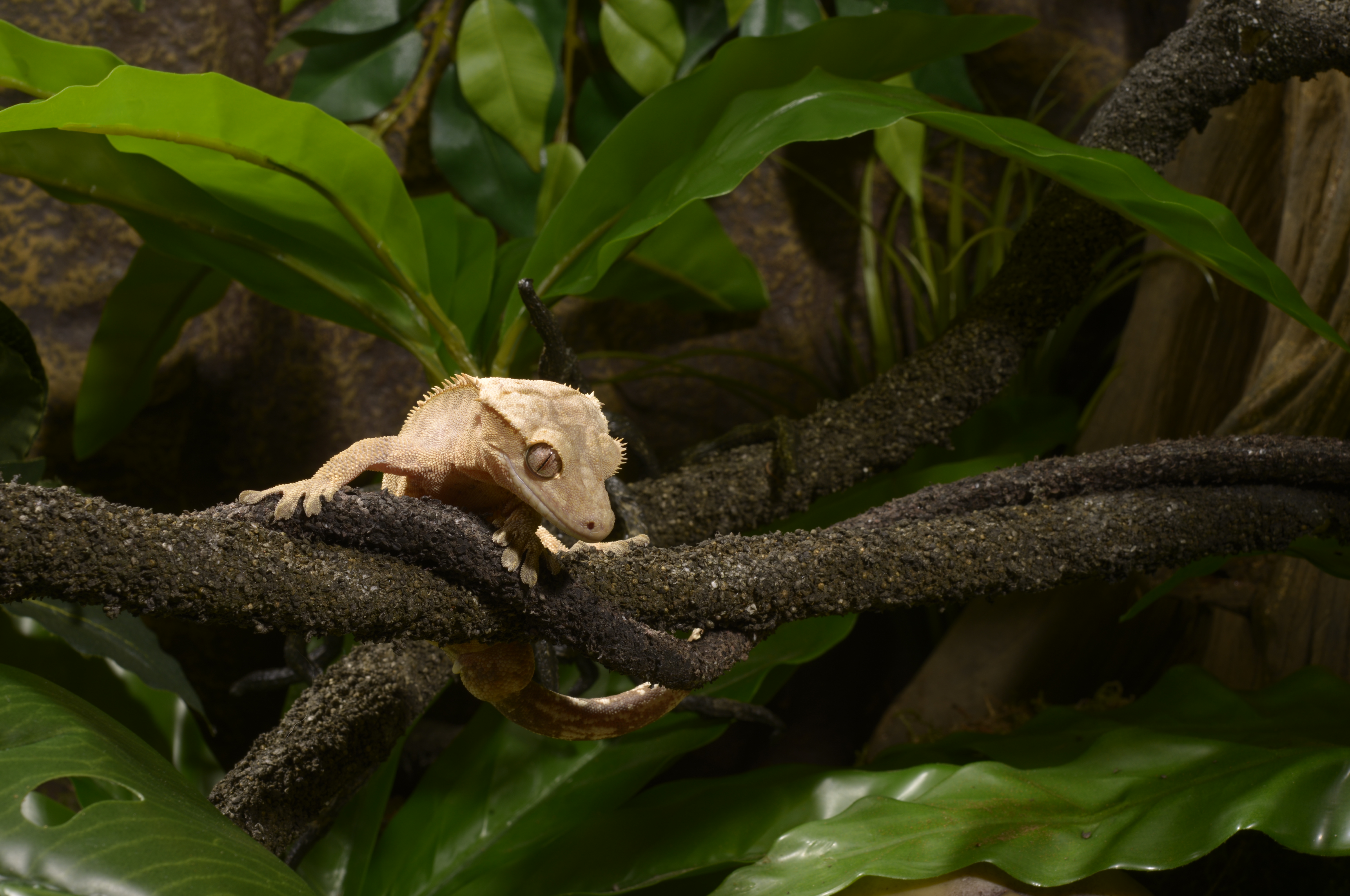
Terrarium
Exo Terra Natural Terrariums, designed by European herpetologists, offer several housing options for crested geckos. These glass terrariums feature front opening doors, allowing easy access for maintenance and feeding and a unique double ventilation system with full screen stainless steel top.
The small to medium sizes are recommended for adults of these lizards but juveniles should be raised in nano or mini size terrariums.
Up to three adult crested geckos can be housed in the small sizes and up to five in the medium sizes. The two front doors allow for easy maintenance and the unique ventilation design provides the air flow required for this species.
The Exo Terra Natural Terrariums Large Tall & X-Tall can be used as well to create even more spectacular displays, but we do not recommend to house more than 5 animals - 1 male and 4 females.
Exo Terra also offers Crested Gecko Habitat Kits which come with all the components necessary to a successful start. All the features of these kits are based on the knowledge gathered during the Exo Terra Crested Gecko Expedition, in combination with information on captive husbandry from well-known Crested Gecko breeders.
Exo Terra Screen Terrariums are suitable when the average room temperature is 72º F or 22° C, or above and a moderate to high relative humidity can be maintained. The Exo Terra Screen Terrarium is a perfect habitat for arboreal reptiles and provide optimal ventilation while minimising odours and fungus growth.
The substrate tray allows you to place a small layer of substrate to absorb spray water and increase humidity levels. It can easily be removed from the enclosure through the swivelling bottom door. The sturdy latches add stability to the enclosure and keep your Crested Geckos safe & secure.
Screen Terrariums are only suitable to house adult Crested Geckos, juveniles should be housed in the smaller Exo Terra Natural Terrariums.
Lighting
Crested geckos are nocturnal and will spend most of the day immobile primarily resting in foliage or, if not available, in leaf litter or hide-outs. Although they sleep during the day and are active at night, because they rest in foliage they are more tolerant of light than most nocturnal geckos.
The terrarium should be placed in dark rooms or in rooms receiving indirect light from windows and should never be placed near a window where it can receive direct sunlight. This could cause it to overheat and stress or kill your geckos.
For daytime lighting in terrariums with live plants, the Exo Terra Natural Light fluorescent lamps will provide a nice quality of light for viewing and for growing plants. These lamps can be used with various Exo Terra fixtures, like the Compact Top, Light Dome or Reptile Dome.
Incandescent lights, like the Daytime Heat bulb or the Daylight Basking spot are recommended to provide heat if temperatures are too cool (see “Heating” section).
In terrarium rooms where the ambient temperature averages around 74° F or 23°, and when no life plants are used - the Exo Terra Day & Night LED is ideal. The bright white LED’s create a nice daylight, while the blue LED’s mimic a moonlight shimmer that enables you to observe your animals at night without disturbing their natural behaviour.
When using a Screen Terrarium, the best option is an Exo Terra Daytime Heat bulb or the Daylight Basking spot during daytime and an Exo Terra Night Heat bulb or Infrared Basking Spot during nighttime combined with a Light Dome or Reptile Dome.
Heating
Monitoring
Crested Geckos require a specific temperature range both during night and the day to thrive (see “Heating”). They also do best at a relative humidity of around 70%.
Use the Exo Terra Digital or Analog Thermometers and Hygrometers to help you monitor the terrarium conditions and adjust the temperature and relative humidity to meet the needs of the animals.
Substrates
Crested Geckos are primarily arboreal but will come to ground level to feed, lay eggs and sometimes use ground level hide-outs. The floor of their forest habitat consists of leaf litter scattered over limestone and a sandy organic soil that tends to retain moisture in part because of regular rainfall and moderately high relative humidity.
All of Exo Terra’s Tropical Substrates can be used with Crested Geckos. Plantation Soil, moistened and patted down is a great choice to reduce any risk of ingestion when live insects such as crickets are offered. It is also one of the best substrates when adding live plants. It is good medium for Crested Gecko to lay eggs in.
Highly recommended are the Exo Terra Dual Layer substrates like the Tropical Forest Floor, Bamboo Forest Floor and Equatorial Forest Floor. These multi layer substrates allow to recreate the forest floor as found in natural forests with a decorative top layer and a hygroscopic base layer.
Rain Forest, Jungle Earth and Forest Bark work well when Exo Terra’s Crested Gecko Food or a pureed diet is offered but present a small risk of ingestion if live insects are offered. All of these substrates absorb water and will help raise relative humidity in the terrarium.
Plants
Crested Geckos will choose to rest and spend the day on and between the foliage of plants. Exo Terra offers a wide range of artificial plants that will be utilised as dwelling, resting and hiding. Broadleaved Hanging Plants are the best choices.
Crested Gecko terrarium can also be decorated with live plants. Bird's-nest ferns, Ficus benjamina, Dracaena species with densely stacked leaves, spineless bromeliads and devil's vines are among the best choices for Crested Geckos.
Make sure they have no pests before introduction and rinse leaves thoroughly to remove any pesticide residues. Many hobbyists choose to introduce live plants in pots that are buried in the substrate and concealed with sections of cork bark or other landscape structures.
Considering their natural behaviour, Crested Geckos should be provided with a few wood branches or other structures they can climb on to access foliage. Predominantly during nighttime, Crested Gecko spend much of their time foraging on these. Natural branches like Exo Terra’s Forest Branch or artificial branches work very well.
The Exo Terra Moss Vine and Jungle Vine are ideal as they can be bent and shaped according to the desired set-up to enlarge the dwelling area. These water-proof vines are bendable, twistable life-like vines with a natural feel and look and can be twisted together with vines of different sizes to create a 3D habitat.
Another great addition to the terrarium display is the Exo Terra Jungle Tree which has multiple bendable branches.
Make sure that some of the vines and branches have horizontal segments for the Crested Geckos to rest and perch.
Hide Outs
Since Crested Geckos are arboreal, the ideal hide-out is the Exo Terra Canopy Cave that can be mounted at higher levels of the terrarium. These elevated hide-outs can be easily removed from the specially designed clip and have a spy window to observe the geckos inside.
Crested Geckos will use ground level hide-outs by the lack of dense foliage plants, when temperatures are uncomfortable, or the air is too dry. They will also often choose to dig at the edge or under a shelter to lay eggs.
Good choices for ground level hide-outs are Exo Terra’s variety of caves. Crested geckos will also use tree bark, large dried leaves or leaf litter to bury in during the day. The Snake Cave works well for Crested Geckos since its entrance is on top of the hide-out and can be easily accessed by the top lid.
When housing multiple Crested Geckos in one terrarium, ensure that each animal has its own hide-out to prevent stress.
Decor
Landscaping a terrarium will encourage activity and exploratory behaviours. Next to the necessary items like plants, vines and hide-outs - the terrarium can be “beautified” with some additional decor items. Care however needs to be given to not over clutter the open space in the terrarium.
Exo Terra offers a wide variety of innovative decor items like Skulls, Waterfalls, Ground Plants, etc - all which add next to personalising accents, some more environment enrichment and features.
Nutrition
In the wild, Crested Geckos feed primarily on mature fruits, nectar, pollen and flowers; but will equally hunt for insects and other small prey.
Crested Geckos do well on a ready made diet like the Exo Terra Crested Gecko Food - a nutritious food blend that is specially designed for growth and long term health of Crested Geckos. Due to their varied diet, a combination of natural fruits and appropriate amounts of protein were added to create a healthy diet with desirable texture for maximum acceptance.
The Exo Terra Crested Gecko Food contains all essential vitamins, amino acids and trace elements necessary to keep your pet reptile happy and healthy. Each single serve cup provides the optimal amount of food for your geckos, which prevents spoiling, and prohibits Crested Geckos from tracking excess food throughout the terrarium.
Use an Exo Terra Cup Holder to position the Crested Gecko Food cups at higher levels in the terrarium.
We recommend to feed insects at least once a week to keep your geckos alert and active. Crickets are the best choice for feeding Crested Geckos. When selecting a size for crickets, figure the length of the cricket should be about same as the width of a gecko’s head. Crested Geckos will also readily take wax worms and some may also eat mealworms. Both of these tend to be fatty so should be fed in small amounts and not as the primary diet.
Because commercially raised insects tend to be deficient in calcium and several vitamins, they must be supplemented by coating with a reptile vitamin and mineral supplement such as Exo Terra Multi Vitamin blended with an equal part Calcium.
If only feeding crickets and mealworms, offer these three times a week after supplementing with Exo Terra’s Multi Vitamin and Calcium using the “shake & bake” method of coating insects.
The Exo Terra Worm Dish with a curved upper lip that prevents wax worms and mealworms from escaping is ideal for this feeding these species. The dish should be cleaned regularly and allowed to thoroughly dry before refilling with worms.
Water
A shallow Water Dish with clean water should be available at all times. Exo Terra Water Dishes are ideal because of a natural appearance and allow for easy cleaning and disinfection.
In addition to water, the terrarium should be lightly misted using an Exo Terra Mister daily, preferably with purified or distilled water to prevent the buildup of mineral stains on the glass sides. This will help maintain the 60-80% relative humidity levels this species prefers. Frequent misting helps stimulate breeding behaviour, and is a necessity when housing live tropical plants such as Bromeliads, ferns, orchids, etc.
Maintenance
Few reptiles are easier or take less time to maintain than crested geckos. Total maintenance time for a single terrarium will be less than twenty minutes a week.
Whether Crested Gecko Food or live insects, adult Crested Geckos should be offered food three times a week - and juveniles daily. Dead insects and other leftover foods should be removed from the terrarium in order to prevent harmful bacteria to build up.
Water dishes should be kept filled at all times and should be thoroughly washed and rinsed regularly or whenever fouled.
The terrarium should be misted daily, preferably with purified or distilled water to prevent mineral stains on the glass.
Before watering the substrate once a week to keep it moist, spot clean any faecal or food residue. Stirring and mixing the moist substrate will allow soil bacteria to break leftover traces of waste down.
Live plants should be watered once a week whether in pots or planted directly in the substrate.
Clean the inside glass and decoration once or twice a week with plain water to remove any waste matter. The outside (NEVER the inside) glass can be cleaned with a paper towel and window cleaner.
Breeding
For breeding purposes, Crested Geckos are best housed with 3 geckos per terrarium, one male and two females. Try to avoid interaction, except during regular maintenance schedules.
Monitor temperature and humidity levels at all times. It is recommended to cool down Crested Geckos for one to two months up to 10º F or 5° C from their active warm season daytime temperatures to stimulate breeding behaviour.
Always ensure to provide sufficient calcium and multivitamins when feeding live insects to egg-laying geckos.
Set-up a secure nesting shelter, padded with moist moss that is easily accessible to remove the eggs. Recently deposited healthy eggs weigh from 2.1 gram to 2.25 gram and measure 21 to 23 mm in length and 11 to 12 mm in width.
Place the eggs, without rotating them, in the Exo Terra Incubator at 77° F or 25° C, on a moist incubation medium like moss, Vermiculite or Perlite. Keep the medium moist at all times. Eggs usually hatch after 70 days.
When incubating eggs at lower temperatures, it can take up to 100 days to hatch - and at higher temperatures it might only take 60 days. Never expose the eggs to temperatures above 29°C.
Handling
We don’t recommend the handling of Crested Geckos when not necessary.
Crested Geckos are animals that are best observed, but many owners choose to handle their geckos just so they become used to being picked up and occasionally held. As a rule, baby crested geckos should NOT be handled. It will stress them and there is a risk they will dart, fall and injure themselves. They are tiny and difficult to hold unless one cups them in hand.
You should wait until crested geckos are at least 3.5 inches snout-to-vent before handling them. Crested geckos should always be held above a surface, such as table or a lap so that an accidental fall does not cause injury. When picking up a crested gecko it should always be held loosely and never grabbed tightly, which it will interpret as a sign of threat. Handling periods should always be short, ten minutes or less.

Conclusion
Crested Geckos are an ideal beginner’s animal and rank among the top ten of the most economical and easiest to keep of reptiles. They make beautiful displays in planted terrariums and come in a wide range of attractive colours and patterns.

Did You Know?
When a Crested Gecko loses its tail, it is called a “frog butt” amongst reptile people, because once the tail is dropped, the rear end resembles a frog’s butt.
Crested geckos do not have eyelids, but a transparent scale to keep the eyes moist. The geckos use their tongues to clear away small debris and water droplets.
Crested Geckos eat their shed skin to avoid wasting valuable nutrients.
Frequently Asked Questions
My Crested Gecko is turning white! Is it sick?
No, Like all reptiles, Crested Geckos shed their skin regularly. When about to shed they will turn to a whitish colour. Shedding will then generally occur within 24 to 48 hours.
My gecko lost its tail, does it harm him/her?
Tail loss among Crested Geckos is actually not uncommon and does not harm the animal. In the wild, most adults are found without tails. Other than physical appearance, tailless geckos live a normal life and are not to impaired in any way.
Will my Crested Gecko’s tail grow back?
Unlike most other geckos, the tail will not grow back once it has been lost. Once a “Frog butt”, always a Frog Butt.
Why does the dropped tail continues to wiggle?
The wiggling tail is meant to fool predators, they will likely be attracted by the moving tail so the gecko can escape “unharmed”.

Other species
Agalychnis callidryas
Red-Eyed Tree Frogs are native to Mexico, Belize, Guatemala, Honduras, Nicaragua, Costa Rica, Panama and even occur in some isolated populations in Colombia. They primarily prefer tropical rainforests and humid lowland forests but can sometimes be found in humid forests on premontane slopes up to 1250 m above sea level.
The Red-Eyed Tree Frog's common name refers directly to the beautiful, big red eyes that these frogs show at night. Red-Eyed Tree Frogs are sometimes referred to as Red-Eyed Leaf Frogs as well because of their arboreal lifestyle, sleeping on the back of the leaves in the trees and shrubs that they live in.
Red-Eyed Tree Frogs are stunning, long-lived and relatively “easy-to-care-for” amphibians. Their engaging personalities, their huge bright red eyes, bright green dorsal color with blue striped sides, and their bright orange webbed feet, make them one of the most stunning display animals for both the beginning reptile enthusiast as well as for the advanced hobbyist.
Red-Eyed Tree Frogs are a fairly social species and are best enjoyed when kept in small groups of 4 to 8 animals. The interaction between the animals in these small groups increases the viewing pleasure but also stimulates their mating behavior.
Red-Eyed Tree Frogs have been captive bred in the USA and Europe for more than 30 years. They are available in various local color variations and even an "albino type" morph with yellowish dorsal coloration and silver eyes called "lutino" is sometimes offered.
Anolis carolinensis
Green Anoles are native to the Southeastern United States, but have also been introduced to Hawaii, Ogasawara Islands of Japan, Cuba, the Bahamas, and Guam. Green Anoles are diurnal, primarily arboreal, iguanid lizards of the Genus Dactyloidae. Green Anoles mostly inhabit trees and shrubs in tropical & subtropical evergreen forests, but can just as well be found in open grassland with only a few trees, and even in rural and urban areas.
With their changing base color from brown to vivid green, their reddish-pink colored dewlap and their interesting displaying behaviour, these terrarium inhabitants rank among the most popular and easiest to keep beginner reptiles.
Green Anoles are a fairly social species and are best enjoyed when kept in small groups of 1 male with 3 or more females. The interaction between the animals in these small groups increases the viewing pleasure but also stimulates their mating behavior.
Green Anoles have been captive bred in the USA and Europe for more than 30 years. Green Anoles are available as captive bred specimen as well as wild-caught specimen using sustainable ranching and size-selective harvesting.
Bombina orientalis
Fire-Bellied Toads are endemic to Northeastern China, Korea, and the Khabarovsk and Primorye regions in Russia. Despite their common name Fire-Bellied “Toad”, these cute amphibians are actually frogs. As the name already indicates, their bellies are brightly colored in orange, yellow or red. These strikingly colored bellies are actually a warning sign (called aposematic coloration) to inform predators that they are distasteful and should not be eaten.
Fire-Bellied Toads are hardy, long-lived and “easy-to-care-for”. Their semi-aquatic lifestyle, their exposure of belly colors as they float at the water surface, and their somewhat clumsy “amusing” motions make them appealing display animals for both the beginning reptile enthusiast as well as for the advanced hobbyist.
Fire-Bellied Toads are a fairly social species and are best enjoyed when kept in small groups of 4 to 8 animals. The interaction between the animals in these small groups increases the viewing pleasure but also stimulates their natural- and mating behavior.
Ceratophrys ornata
Ornate Horned Frogs are hardy, long-lived, and “easy-to-care-for” amphibians. These large, terrestrial, burrowing frogs are native to South America and are characterized by more or less developed fleshy horns projection above the eyes.
The Ornate Horned Frog is only one of eight species of Horned Frogs:
Ornate Horned Frog (Ceratophrys ornata)
Cranwell’s Horned Frog (Ceratophrys cranwelli)
Suriname Horned Frog (Ceratophrys cornuta)
Brazilian Horned Frog (Ceratophrys aurita)
Caatinga Horned Frog (Ceratophrys joazeirensis)
Venezuelan Horned Frog (Ceratophrys calcarata)
Pacific Horned Frog (Ceratophrys stolzmanni)
Ecuadorian Horned Frog (Ceratophrys testudo)
The Ornate Horned Frog is one of the most commonly kept and bred Ceratophrys species. Horned Frogs are colorful and rather easy to breed which makes these fun frogs an ideal species for both the beginning amphibian enthusiast as well as for the advanced hobbyist. Captive-bred youngsters are readily available and come in a variety of colors & patterns. Next to the more common color morphs like Pattern-less Green, Strawberry, Sunburst, Albino or Chocolate, there are even hybrid morphs available called Fantasy Frogs.
Horned Frogs are commonly called Pac Man Frogs because their rounded shape and huge mouth resemble the animated character in the video game. Just like in the Pac Man game, the Horned Frogs devour everything that crosses their path.
Chamaeleo calyptratus
Veiled Chameleons or Yemen Chameleons are native to Yemen and Saudi Arabia. There are also introduced populations in Hawaii (thought to be eradicated but still persisting), California and SE and SW Florida, USA. They primarily prefer montane subtropical to tropical vegetation in the deep valleys (called wadis), in the Hijaz Mountains in Saudi Arabia and Yemen.
Since Yemen is suffering for over a decade of war and is not an easy country to travel to, or to export animals from, it is amazing how this species was established so well in the hobby. One of the first to study this species in nature, as well as establish the captive husbandry guidelines, was the world-renowned herpetologist Petr Necas. He bred tens of thousands of Veiled Chameleons and introduced these to the hobbyists in Europe and the USA. In the meantime, this species has become not only the most readily available chameleon, but also one of the more popular reptile species in general. Due to selective breeding, there are "bloodline" variations of the Veiled Chameleon available that show more yellow/orange or bluer and there's even a partially leucistic color morph available (called translucent in the USA).
Cruziohyla sylviae
Sylvia's Tree Frogs are native to Costa Rica, Honduras, Nicaragua and Panama. They prefer primary tropical rainforests located at low to mid elevations, up to 750m above sea level. The type locality of the Sylvia's Tree Frog is Guayacán in the province of Limón, Costa Rica.
The Sylvia's Tree Frog's common name refers to the 3-year-old granddaughter of the Herpetologist Andrew Gray, who described the species in 2018.
Sylvia's Tree Frogs are stunning, long-lived and relatively “easy-to-care-for” amphibians. Their engaging personalities, bright green dorsal color, their orange with black tiger striped flanks, and their bright orange webbed feet and inner thighs, make them one of the most stunning display animals for both the beginning reptile enthusiast as well as for the advanced hobbyist.
Sylvia's Tree Frogs live an arboreal lifestyle, sleeping on the back of the leaves in the trees and shrubs that they live in.
Sylvia's Tree Frogs are a fairly social species and are best enjoyed when kept in small groups of 4 to 8 animals. The interaction between the animals in these small groups increases the viewing pleasure but also stimulates their mating behavior.
Sylvia's Tree Frogs have been captive bred in the USA and Europe for several years now, but were mostly mistakenly named Cruziohyla calcarifer, until Andrew Gray described the species as Cruziohyla sylviae.
Stay up on all things exo terra.
"*" indicates required fields


